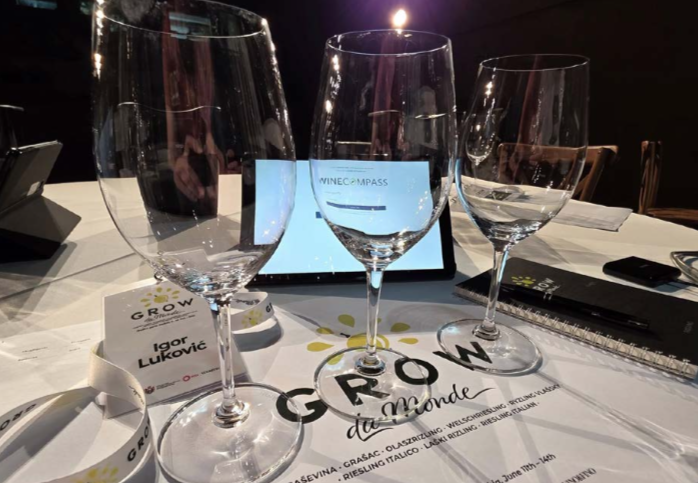The Riesling Italic wave is GROW(ing)
The popularity of the grape variety – also widely grown in Italy, particularly in Oltrepò Pavese – is spreading from the Balkans to Eastern Europe, driven by a movement founded by three wine professionals.

An invisible bridge linking the Balkans and Eastern Europe, with branches extending into Central and Southern Europe. Not an infrastructure project, nor the invention of a mad scientist, but Italic Riesling. Whether it’s called, by its Italian name – Riesling Italico – or by its regional variants – Grasac (Serbia), Graševina(Croatia), Olaszrizling (Hungary), or Laški Rizling (Slovenia) – this white grape variety, genetically unrelated to the more famous“German Riesling” (Rhine Riesling), is at the centre of a renewedwave of interest driven by a broader movement to rediscover and revalue its potential. Behind this revival is a network of wine professionals – supported by geneticists and ampelographers – whohave created a true cultural movement around Italic Riesling. The acronym “GROW” brings together the initials of the grape’snational names: “G” for Graševina and Grasac, “R” for Riesling, “O” for Olaszrizling, and “W” for Welschriesling, as the grape isknown in Austria. “GROW du Monde” is the name of the annualwine competition where producers from these countries put their Italic Riesling wines to the test. Judging is conducted by an international panel of expert tasters – including several Masters of Wine – led by the movement’s founders: Igor Luković (Serbia), Saša Špiranec (Croatia), and Zoltán Győrffy (Hungary). All wines are blind tasted, and the host country changes every year. The 2025 edition took place in June in Serbia, between the Fruška Gora wine region and the capital, Belgrade, which hosted both the awards ceremony and a public festival where wine lovers could sample many of the competing wines. A success that is set to continue in 2026, when the Czech Republic will host the next edition, in collaboration with wine journalist and critic Michal Šetka. The resurgence of Italic Riesling in the Balkans and Eastern Europe is driven by the grape’s remarkable versatility. From Charmat and traditional method sparkling wines, to dry still wines, dessert wines and skin-contact “orange” wines, “Riesling Italico” is becoming a valuable asset for many producers. “There are countless interpretations,” says Igor Luković. “The wines made from the varieties represented in the GROW acronym can be light and fresh – perfect for summer – or rich and structured, ranging from dry to sweet. Riesling Italic performs well in stainless steel, ideal for more immediate styles, but it also handles oak exceptionally well. What’s striking is how, in every producing country, the grape expresses a unique identity, while still retaining certain common traits.”
Hungary is among the countries investing most in this variety. Along the northern shores of Lake Balaton, not far from Budapest, a PDO has been established specifically for Olaszrizling: Balatonfüred-Csopak. Progress is being made on the genetic front as well. Italic Riesling, now widespread across Danubian countries, remains a mystery in terms of origin. Italy is the only country to have addressed the issue scientifically, thanks to a team of researchers at the National Research Council (CNR), including Stefano Raimondi. “We have likely identified one of Riesling Italic’s two genetic ‘parents,’” explains Raimondi. “It’s CoccalonaNera, a red grape variety historically grown in the Oltrepò Pavese and bordering areas of Piedmont. The other parent remainsunknown.”
 The growing collaboration among countries currently focused on this grape might eventually lead to the identification of the second parent. Meanwhile, in Serbia, at the Andrej Volny Herbariumhoused in the Karlovci Gymnasium in Sremski Karlovci, researcher Milica Ray safeguards what may be some of the earliest physical traces of the grape – genetic material such as leaves and seeds, discovered by chance in an abandoned chest. Who knows? The GROW project might not only bridge culturesand terroirs, but also connect researchers in uncovering the full story of a variety that still holds many secrets.
The growing collaboration among countries currently focused on this grape might eventually lead to the identification of the second parent. Meanwhile, in Serbia, at the Andrej Volny Herbariumhoused in the Karlovci Gymnasium in Sremski Karlovci, researcher Milica Ray safeguards what may be some of the earliest physical traces of the grape – genetic material such as leaves and seeds, discovered by chance in an abandoned chest. Who knows? The GROW project might not only bridge culturesand terroirs, but also connect researchers in uncovering the full story of a variety that still holds many secrets.
